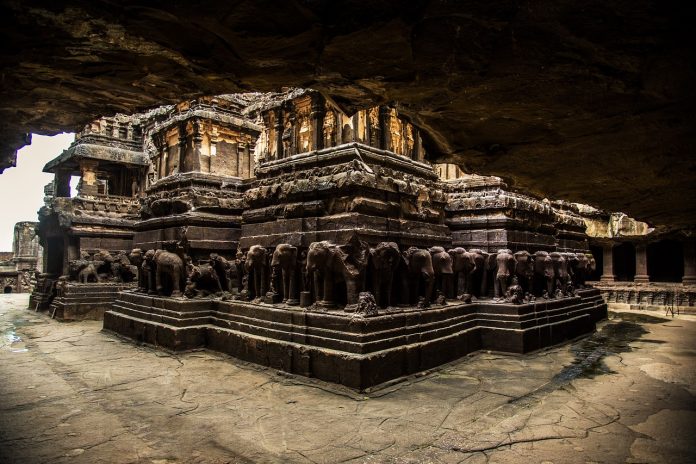The historical Indian Rock cut architecture is of unmatched importance and depicts the ancient India by their unique excavated interiors. These medieval and time-honoured structures were carved out of solid rocks for a variety of reasons and thus have a very interesting story behind the construction of each one of them. Many of these atavistic monuments are today listed in the United Nation Heritage sites and attract thousands of tourists every year. Below is the list of 5 best rock cut architectures in India which you would love to visit.
Ajanta Caves

What comes to our mind when we think about an historical paragon is this beautiful structure located in the city of Aurangabad. Discovered in 1819, the Ajanta Caves are believed to be a Buddhist monastery that provided refuge and shelter to Buddhist monks during rains. These caves built in 200 BCE are a sculpture of Indian craftsmanship and reflect the illustrious past of our country.
The 29 rock cut caves are a fountainhead of inventive ancient architecture with marvelously carved male and female representations. Various curious architects have been inspired by this stupendous artwork trying to create replica of Ajanta paintings and sculptures in their paintings.
Ellora Caves

Ellora caves are a group of 34 monasteries and temples housing the best collection of the medieval art and contain ancient artifacts of global importance. It is considered to be an engineering and art wonder which took 100 years of flawless carving. The cave contains 12 Buddhist temples, 17 Hindu shrines and 5 Jain temples. Representing three religions, these caves remarkably describe the eminent religious integrity of the country.
One of the many famous and unbelievable creations here is the Kailasanatha temple, which was made to resemble Mount Kailash. This free standing structure outlines the perfection and delicacy of the ancient Indian architecture. The Ellora caves is one of the most visited tourist places in Maharashtra.
Panch Rathas, Mahabalipuram
This unique set of five shrines and three large sculptures of animals located in Mahabalipuram is one of the most enduring rock structures in the country. Noticeably, the Panch Rathas are adorned with excruciating stone carving from a single stone. Built long back in 7th Century AD, this astounding monument is located in Mahabalipuram which is believed to be the temple city of Pallavas.
The three different shrines delineate the diverse and rich tradition of Hinduism as a religion. The rathas are symbolically related to the epic Mahabharata portraying the five ‘Pandavas’. Although there are a couple of stories behind this authentic rock cut structure, yet the real reason behind its construction is still a mystery.
Elephanta Caves
Located on a small island near Mumbai, Elephanta caves are known for its archaeological remains and its impressive artistic value. This 39 metres deep cave can take you into the world of dynasties and emperors that once lived in it. Built between 5th-8th century AD, it contains five Hindu shrines and two Buddhist monasteries. The cave contains the famous Trimurti which resides at the entrance and is a three side facing sculpture of lord Shiva. The two gracefully worked out statues named the Taptapurusha and Vamadeva are placed as an epitome of preserver and destroyer Shiva respectively.
Masrur Temples
The allurement of the astonishing Masrur Temples built in Nagara style can never fail to leave you open-mouthed. Located in Kangra Valley, this distinguished wonder is known to have been built miraculously. The temple contains 15 steep sided pyramids namely the Sikharas which are crowned with beautiful stone carvings. The 50 meters long rectangular water tank emphatically adds to the splendid beauty of the temple.
They are possibly the oldest examples of the Nagara style defining the importance of finest artisan-ship and religious belief in Indian art.
By experiencing any of these magnificent architectures, one can imagine the times and lives of the past. The stories, the creations and the staggering architecture of these structures elucidate that they would unquestionably represent the ancient Indian culture for a long time to come.




